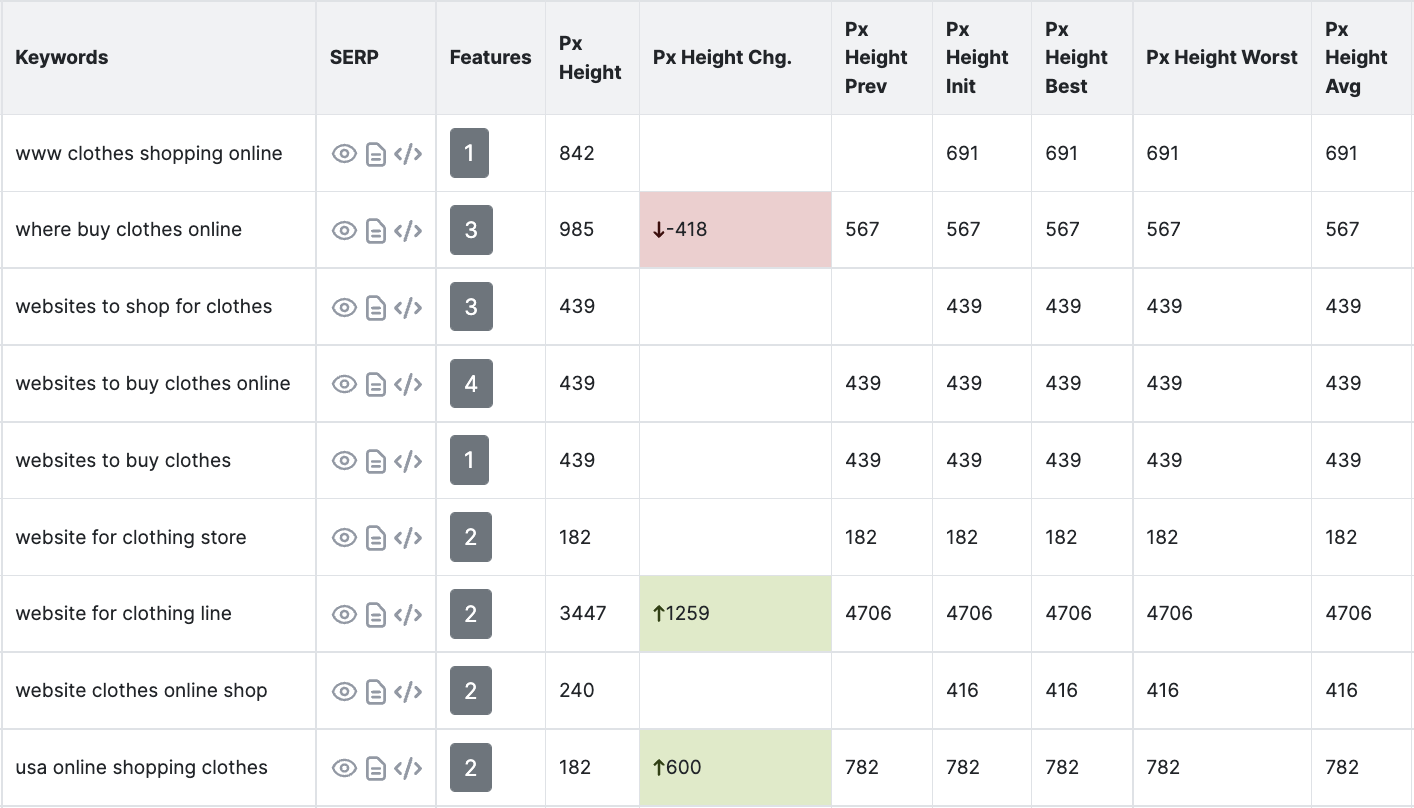We’re not talking about keyword research. Let’s start when you already have your keywords. We’ll call this your keyword portfolio.
Where you got this list doesn’t matter. You’re either ranking for them or you intend to. Hopefully, they’re mapped to a content strategy. Whether you’re focused on topic clusters, specific personas, or the entire marketing buyer’s journey, content built with SEO in mind deserves love like a box of old comic books or a 1964 Pontiac GTO.
Manually segmenting your keyword portfolio is that labor of love. There’s purpose and value. You have a section of keywords tied to specific content that needs to rank and drive business value.
Let’s speed up that workflow with AI.
Table of Contents
ChatGPT and SEO
Before you roll your eyes, consider the opportunity.
ChatGPT polarized the SEO community. Since last November when ChatGPT went viral, SEOs have raced to incorporate it into their workflows.
Despite fair warnings of its limitations, LinkedIn and Twitter have been a desperate carousel of use cases both valuable and misguided. We’ve seen fascinating Python scripts for persona development. We’ve seen people claim that ChatGPT can determine keyword search volume (it cannot).
With ChatGPT, you produce a prompt and it produces text. It’s a sophisticated large language model trained on billions of documents. In essence, it takes your prompt and predicts the next word at an insanely complex level. It feels like you’re conversing with a real human, but it’s smoke and mirrors.
The technology is advancing rapidly with a GPT-4 version available commercially. Currently, you cannot access the internet with the free version, but with the impending addition of 3rd-party plugins, users will be able to have ChatGPT consume and interact with real-time web content. You can leverage Bing’s Open AI integration and Google’s Bard. Which tool is the best? That’s still up for debate.
But as an SEO, when we implement ChatGPT specifically, it’s critical that we understand what it can and cannot do.
- It’s trained on data from 2021. You cannot ask it to analyze the content on a URL.
- It’s not always factually accurate. It hallucinates frequently, meaning it makes up information and delivers it confidently.
- It can lack consistency in output. Chances are if you provide the same prompt, you will receive two different results.
The consequence: any content output needs to be reviewed and fact-checked.
Will it always be unreliable? No. But right now, you need to take its generated text with a grain of salt. If you work in the health or financial industry, I’d recommend significantly increasing your scrutiny.
That said, ChatGPT can summarize, ideate, and categorize text. It can write some code and markup. The potential for the tool grows exponentially by the day. For instance, AIPRM has nurtured an entire community for prompt building with a variety of SEO-focused prompts.
ChatGPT and Keyword Segmentation
Historically, keyword segmentation would be a manual process. Unless you were using a tool that had built its own classification system like Semrush with search intent, then you had to go through each keyword and classify it yourself.
Why does keyword segmentation matter?
As SEOs and content creators, we have limited resources to create and optimize content. Not all keywords are created equal. Beyond search volume, a surgical focus on keyword segments that impact business revenue and growth opportunities can determine the financial health of your business.
- If you’re a seasonal business, why not focus on seasonal keywords?
- Do you have a local physical presence? Then you’d probably want to ensure that you fortify your strongest locations and either abandon or double down on rebuilding your weakest.
- If you’re a media publisher, do you depend on evergreen content to sustain your business model? Slicing that segment out from your trending journalism will keep your financials safer.
Every industry and business type has segments that drive revenue and require careful tracking.
Traditionally, keyword portfolios are segmented by topic clusters, need states, personas, taxonomy, and business-driven segments. If you’re providing keyword rank tracking performance reports to execs or doing it for yourself, those segments are table stakes.
At this point, if you’ve realized that you don’t have a list of keywords to segment, you might want to back away from this blog post slowly like Homer Simpson into the hedges. It’s a reminder that SEO requires strategy and planning.
When you’re picking out a keyword for each campaign, you’re setting yourself up for failure. You’re not seeing the bigger picture and ultimately, you’re less likely to rank for any of your content organically in search.
If you need to start your keyword portfolio from scratch, you can export your Google Search Console keyword list and start from there. If you want a data-driven approach, you can contact the team at iPullRank for a keyword portfolio consultation.
Now, if you’re still with us, you can get creative with the way that you segment your targeted keywords.
We’ve got a list of segments in this article, but what if you want some assistance in thinking outside the box with keyword segmentation?
Keyword Segmentation Ideas Prompt:
Act as an expert SEO. Generate segmentation ideas for a {business type] business to build an effective and nuanced SEO strategy tailored to a specific business type, industry, main service or product, target audience, primary keyword, and secondary keyword. Consider the unique aspects of the {business type} in the {business industry} industry, the key features of their {product or service}, the target audience {target audience}, and how to leverage the keywords {primary keyword} and {secondary keyword} for maximum SEO impact. Please provide the output in a well-structured and easy-to-consume format.
This prompt can get you started in ways that you can segment your existing keywords for rank tracking.
Now, there are already a growing number of valuable prompts that are helping SEOs save time, produce more, and compound their creativity. But the key to success lies in Prompt Engineering. Your ChatGPT output is only as valuable as the prompt your input.
The truth of this growing discipline is that it requires trial and error. If your prompt is successful 80-90% of the time, then you can feel confident that you can use it in a range of applications. Just keep in mind that doesn’t absolve you from reviewing the work.
What makes a great prompt?
There are many frameworks for quality prompting. A growing trend has been asking ChatGPT to create an optimized prompt, and frankly, that might be the future of prompt engineering.
But the framework that’s been most effective for me has an educational slant.
Prompt Framework:
- Persona context: What identity should the ChatGPT assimilate to most competently execute the prompt?
- Additional context: What other information is critical to the success of completion?
- Steps/Tasks: What does ChatGPT need to do to accomplish the ask?
- Expected Format: What type of output are you looking for?
- Examples: The best way to highlight your expectations of output is with specific examples.
- Constraints (optional): In the event that your output contains unwanted content, it can be necessary to add constraints.
When you use these prompts for your own specific projects, anticipate some trial and error. You will need to tweak the prompts based on the nuance of your own website.
As you build out these segments in ChatGPT, make sure that you copy them into a spreadsheet for future use. Use this template if you want to track your rankings in ExactScience.
Once you have your keywords categorized, you can upload them and begin digging into your ranking analysis.
Let’s get to the keyword segmentation categorization ChatGPT prompts.
Using ChatGPT to Categorize by Need State
We’ve all developed a different understanding of the buyer’s journey.
The AIDA model dictates:
- Awareness: Awareness for the product is awakened (inspiration)
- Interest: The interest in the product is increased (favoritism)
- Desire: The customer is considering buying the product (wish)
- Action: The product is bought (implementation)
HubSpot evangelizes the simplified inbound funnel version:
- “Awareness Stage: The buyer becomes aware that they have a problem.
- Consideration Stage: The buyer defines their problem and considers options to solve it.
- Decision Stage: The buyer evaluates and decides on the right provider to administer the solution.”
There are many other versions of the buyer’s journey including the circular model and Google’s understanding of the messy middle.
At iPullRank, we believe that the journey has 6 stages:
- Awareness: Keywords related to the discovery of a product, service, or brand.
- Familiarity: Keywords related to getting to know more about a product, service, or brand.
- Consideration: Keywords related to comparing and evaluating options before making a decision.
- Purchase: Keywords related to the actual buying process.
- Loyalty: Keywords related to post-purchase engagement and advocacy for a product, service, or brand.
- Experience: Keywords related to the overall experience or satisfaction with a product, service, or brand.
Regardless of the buyer’s journey that your organization adopts, these segments have different search volumes and value to the bottom line of your business.
Doesn’t it make sense to segment your SEO rank tracking appropriately?
Need State Segmentation Prompt (Based on iPullRank’s Model):
Act as an expert data analyst and expert researcher. Please segment the following list of keywords based on the needs states of the customer journey: awareness, familiarity, consideration, purchase, loyalty, and experience. Assign each keyword to the most relevant needs state according to these definitions:
1. Awareness: Keywords related to the discovery of a product, service, or brand.
2. Familiarity: Keywords related to getting to know more about a product, service, or brand.
3. Consideration: Keywords related to comparing and evaluating options before making a decision.
4. Purchase: Keywords related to the actual buying process.
5. Loyalty: Keywords related to post-purchase engagement and advocacy for a product, service, or brand.
6. Experience: Keywords related to the overall experience or satisfaction with a product, service, or brand.
Keywords: [List of keywords]
Present the output in a table-like format with each keyword and its associated needs state:
Example:
Keywords: digital marketing, online advertising, advertising platforms, ad campaign costs, best advertising agencies, marketing ROI, customer success stories
Output:
Keyword Needs State
-----------------------------------------
digital marketing Awareness
online advertising Awareness
advertising platforms Familiarity
ad campaign costs Consideration
best advertising agencies Consideration
marketing ROI Purchase
customer success stories Loyalty
Using ChatGPT to Categorize by Personas
Personas get a bad reputation. Marketers on social media mock the stereotype of the one-page silly made-up persona and it makes sense. We are individuals and nobody wants to be associated with a group that’s perceived negatively. But a data-driven affinity group can have many overlapping qualities.
If you want to develop your own personas, read Mike King’s epic Moz blog post: Personas: The Art and Science of Understanding the Person Behind the Visit or iPullRank’s The Comprehensive Guide to Marketing Personas.
Everyone’s personas are going to look different. There’s no singular blueprint you can use. Take the time to build out your personas. Once you have your personas, pull out the descriptive name you will use and the 3 key characteristics that you will use in your prompt to help ChatGPT categorize the groups.
Since we will need to explain our personas to ChatGPT, we’ll include that in the prompt.
Persona Prompt:
Act as an expert data analyst and market researcher. Please segment the following list of keywords based on the personas of my brand in the [industry] industry: [Persona 1], [Persona 2], [Persona 3], [Persona 4], [Persona n]. Assign each keyword to the most relevant persona according to these definitions:
1. [Persona 1]: Keywords used by someone who is a [characteristic 1], [characteristic 2], [characteristic 3].
2. [Persona 2]: Keywords used by someone who is a [characteristic 1], [characteristic 2], [characteristic 3].
3. [Persona 3]: Keywords used by someone who is a [characteristic 1], [characteristic 2], [characteristic 3].
4. [Persona 4]: Keywords used by someone who is a [characteristic 1], [characteristic 2], [characteristic 3].
5. [Persona 5]: Keywords used by someone who is a [characteristic 1], [characteristic 2], [characteristic 3].
6. [Persona n]: Keywords used by someone who is a [characteristic 1], [characteristic 2], [characteristic 3].
Keywords: [List of keywords]
Present the output in a table-like format with each keyword and its associated needs state:
Example:
Keywords: [6 keyword examples]
Output:
Keyword Persona
-----------------------------------------
[keyword 1] [persona 1]
[keyword 2] [persona 2]
[keyword 3] [persona 3]
[keyword 4] [persona 4]
[keyword 5] [persona 5]
[keyword 6] [persona 6]
Using ChatGPT to Segment by Topic Cluster
We love topic clusters. What better way to build authority than by covering your core set of topics in-depth? It’s helpful for your audience, future customers, and your own rankings.
Your matrix of content across topics, personas, and need states should clearly map back to your content strategy. Each page on your website should slide right into these topic clusters, but what if you’ve inherited a website that’s in desperate need of the Marie Kondo treatment?
Well, that’s where ChatGPT can help. There are two ways to go about using ChatGPT for topic clusters:
- Provide your own in a prompt
- Allow ChatGPT to create them for you
If you’ve got time on your hands, you can do both.
For this prompt, it’s helpful to have a few examples on hand to include for training purposes.
Topic Cluster Prompt:
Please segment the following list of keywords based on the following topic clusters: [topic cluster 1], [topic cluster 2], [topic cluster 3], [topic cluster n]. For any keyword that doesn’t naturally fit into a topic cluster, assign it as “uncategorized.” Assign each keyword to the most relevant needs state according to these definitions:
1. [topic cluster 1]: [topic cluster definition 1]
2. [topic cluster 2]: [topic cluster definition 2]
3. [topic cluster 3]: [topic cluster definition 3]
4. [topic cluster n]: [topic cluster definition n]
Keywords: [List of keywords]
Present the output in a table-like format with each keyword and its associated needs state:
Example:
Keywords: [topic cluster keyword 1], [topic cluster keyword 2], [topic cluster keyword 3], [topic cluster keyword n]
Output:
Keyword Topic Cluster
-----------------------------------------
[topic cluster keyword 1] [topic cluster 1]
[topic cluster keyword 2] [topic cluster 2]
[topic cluster keyword 3] [topic cluster 3]
[topic cluster keyword n] [topic cluster n]
Not only does the comprehensive coverage of a specific topic help your audience and future customers, but developing in-depth content allows your website to demonstrate topical authority which would improve your ability to rank for higher search volume keywords.
Using ChatGPT to Create Google Sheets Formulas to Segment by Taxonomy
The organization of a website reflects all of the planning that went into creating it. But despite our best intentions, websites can become messy as new content is created and diverts from the original plan. At large ecommerce websites, media publishers, or massive enterprises, the taxonomy of a website can become a densely knotted mess over years of ‘content and technical debt.’
If you’re due for a complete site architecture overhaul, that’s something that iPullRank specializes in. Contact us for a consultation.
But if you’re consistently using categories, tags, facets, or descriptive short naming conventions for your URLs, you can segment the taxonomy of your site by keyword to discover organic performance insights across business departments, products, or educational material. (Stay tuned for a future post that covers layered segmenting of taxonomy and buyer’s journey stages.
Taxonomy is probably the easiest to categorize without ChatGPT if you already have that well-structured website.
For this exercise, you may not need ChatGPT to do the segmenting. All you would need to do is export the URLs and keywords from Google Search Console into a spreadsheet or your categories, tags, and facets from your CMS and create a formula to extract the subfolders then use a VLOOKUP to connect all of the keywords to their taxonomy category.
If you’re not well versed in Google Sheets or Excel Formulas, you can have ChatGPT create that for you.
In this situation, there are a range of tools and extensions that allow you to build formulas using ChatGPT.
Using ChatGPT to Create Spreadsheet Formulas for Other Creative Segments
As you dig into your own data, there are many creative ways to design segments for rank tracking analysis. As you introduce other data sources from revenue operations, customer behavior, ad campaigns, PR initiatives, and SEO experiments you can begin to design custom tags that can help you build a narrative around SEO in the context of your integrated marketing strategy.
- CTR-Driven Segments: How do my highest traffic pages perform against the rest of my website?
- Revenue-Driven Segments: How are my best-converting pages performing?
- Generative AI Segments: How do AI generated/assisted pages rank in comparison to human content?
- Experiment SEO Segments: Do I see a lift in rankings when I implement structured data or adjust title tags?
- Seasonal SEO Segments: Track your seasonal keywords and monitor performance more surgically.
- Barnacle SEO Segments: How are my YouTube videos, social profiles, or brand mentions ranking?
Once you have your keywords and segments designed, upload them to ExactScience and set up custom alerts. Using segmentation to report on SEO rank tracking offers a more targeted way to determine the performance of your SEO campaigns, surface insights with carious experiments, and monitor the health of your business organically.
Get started with a 7 Day Free Trial of ExactScience. Test out your segments on 30 keywords and let us know what you think.




